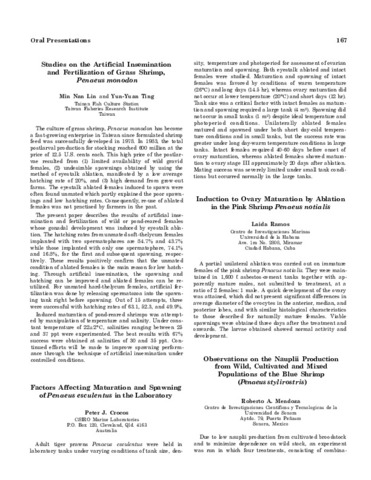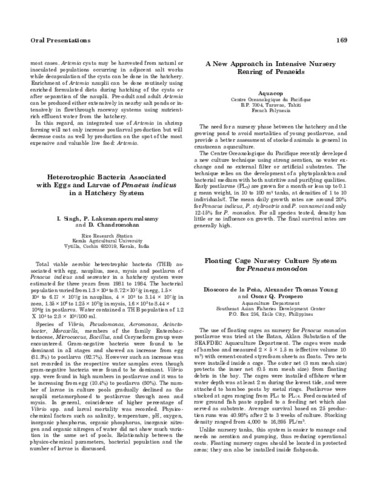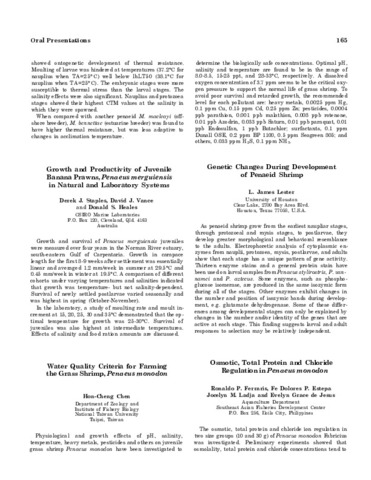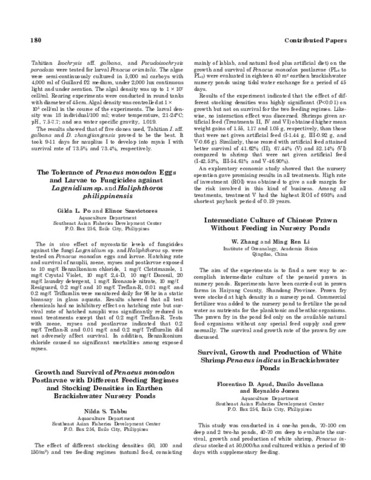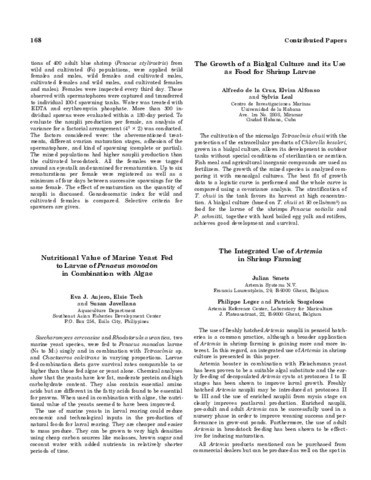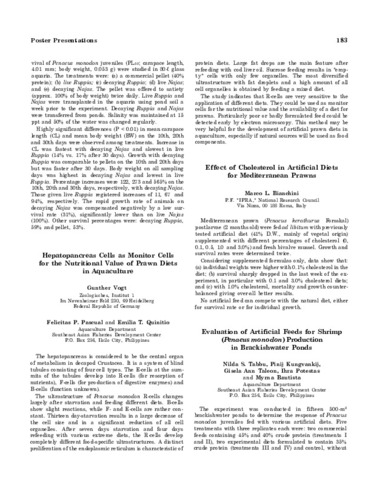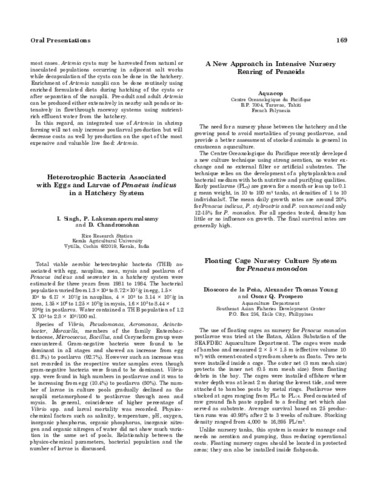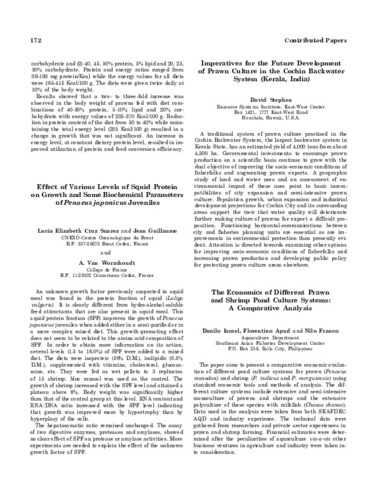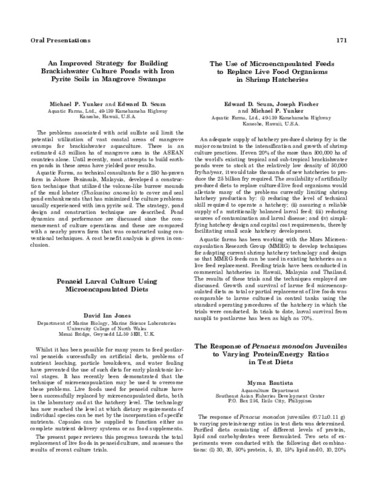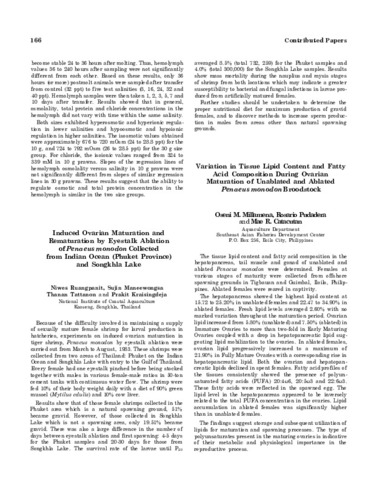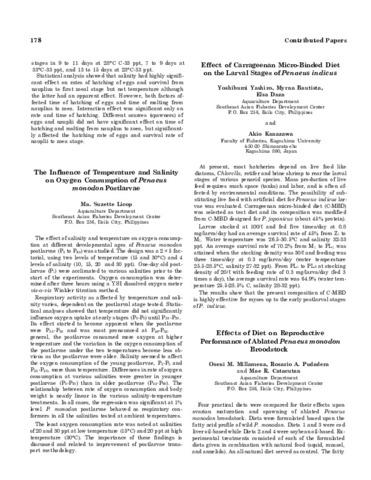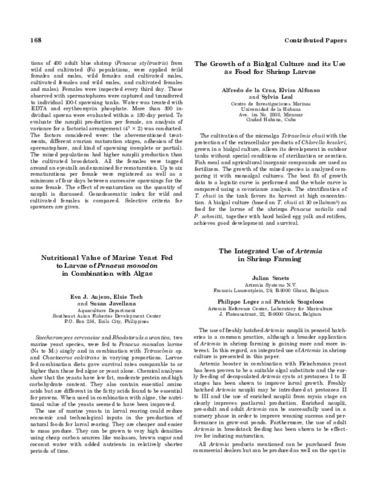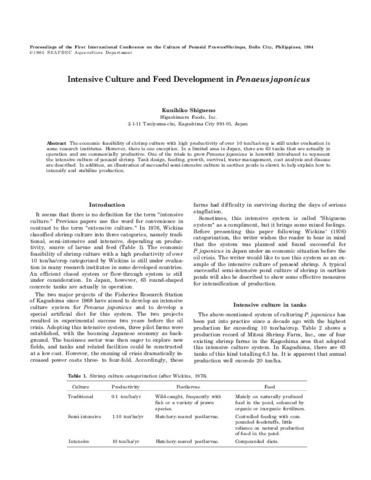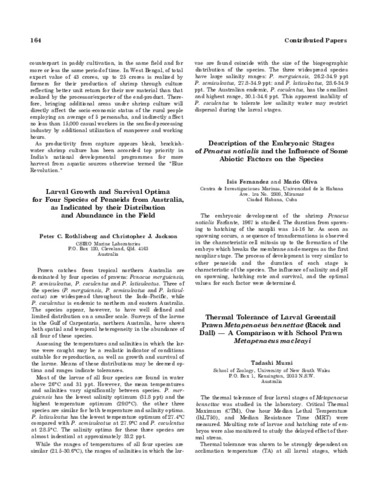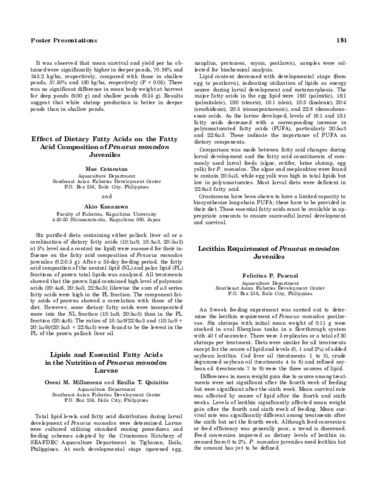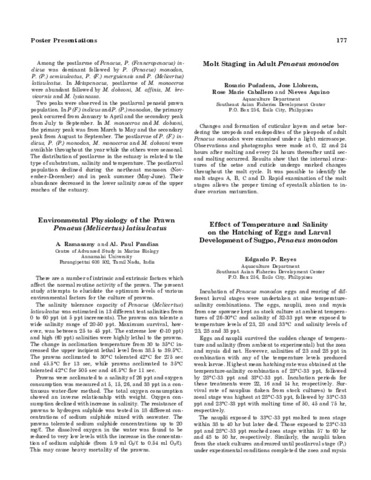Browsing Proceedings of the First International Conference on the Culture of Penaeid Prawns/Shrimps by Title
Now showing items 29-48 of 79
-
Factors affecting maturation and spawning of Penaeus esculentus in the laboratory
(Aquaculture Department, Southeast Asian Fisheries Development Center, 1985)Adult tiger prawns Penaeus esculentus were held in laboratory tanks under varying conditions of tank size, density, temperature and photoperiod for assessment of ovarian maturation and spawning. Both eyestalk ablated and ... -
Floating cage nursery culture system for Penaeus monodon
(Aquaculture Department, Southeast Asian Fisheries Development Center, 1985)The use of floating cages as nursery for Penaeus monodon postlarvae was tried at the Batan, Aklan Substation of the SEAFDEC Aquaculture Department. The cages were made of bamboo and measured 2 × 5 × 1.5 m (effective volume ... -
Genetic changes during development of penaeid shrimp
(Aquaculture Department, Southeast Asian Fisheries Development Center, 1985)As penaeid shrimp grow from the earliest naupliar stages, through protozoeal and mysis stages, to postlarvae, they develop greater morphological and behavioral resemblance to the adults. Electrophoretic analysis of cytoplasmic ... -
Growth and productivity of juvenile banana prawns, Penaeus merguiensis in natural and laboratory systems
(Aquaculture Department, Southeast Asian Fisheries Development Center, 1985)Growth and survival of Penaeus merguiensis juveniles were measured over four years in the Norman River estuary, south-eastern Gulf of Carpentaria. Growth in carapace length for the first 8-9 weeks after settlement was ... -
Growth and survival of Penaeus monodon postlarvae with different feeding regimes and stocking densities in earthen brackishwater nursery ponds
(Aquaculture Department, Southeast Asian Fisheries Development Center, 1985)The effect of different stocking densities (50, 100 and 150/m2) and two feeding regimes (natural food, consisting mainly of lablab, and natural food plus artificial diet) on the growth and survival of Penaeus monodon ... -
The growth of a bialgal culture and its use as food for shrimp larvae
(Aquaculture Department, Southeast Asian Fisheries Development Center, 1985)The cultivation of the microalga Tetraselmis chuii with the protection of the extracellular products of Chlorella kessleri, grown in a bialgal culture, allows its development in outdoor tanks without special conditions of ... -
Hepatopancreas cells as monitor cells for the nutritional value of prawn diets in aquaculture
(Aquaculture Department, Southeast Asian Fisheries Development Center, 1985)The hepatopancreas is considered to be the central organ of metabolism in decapod Crustacea. It is a system of blind tubules consisting of four cell types. The E-cells at the summits of the tubules develop into R-cells ... -
Heterotrophic bacteria associated with eggs and larvae of Penaeus indicus in a hatchery system
(Aquaculture Department, Southeast Asian Fisheries Development Center, 1985)Total viable aerobic heterotrophic bacteria (THB) associated with egg, nauplius, zoea, mysis and postlarva of Penaeus indicus and seawater in a hatchery system were estimated for three years from 1981 to 1984. The bacterial ... -
Imperatives for the future development of prawn culture in the Cochin backwater system (Kerala, India)
(Aquaculture Department, Southeast Asian Fisheries Development Center, 1985)A traditional system of prawn culture practised in the Cochin Backwater System, the largest backwater system in Kerala State, has an estimated yield of 4,000 tons from about 4,500 ha. Governmental investments to encourage ... -
An improved strategy for building brackishwater culture ponds with iron pyrite soils in mangrove swamps
(Aquaculture Department, Southeast Asian Fisheries Development Center, 1985)The problems associated with acid sulfate soil limit the potential utilization of vast coastal areas of mangrove swamps for brackishwater aquaculture. There is an estimated 4.8 million ha of mangrove area in the ASEAN ... -
Induced ovarian maturation and rematuration by eyestalk ablation of Penaeus monodon collected from Indian ocean (Phuket province) and Songkhla lake
(Aquaculture Department, Southeast Asian Fisheries Development Center, 1985)Because of the difficulty involved in maintaining a supply of sexually mature female shrimp for larval production in hatcheries, experiments on induced ovarian maturation in tiger shrimp, Penaeus monodon by eyestalk ablation ... -
Induction to ovary maturation by ablation in the pink shrimp Penaeus notialis
(Aquaculture Department, Southeast Asian Fisheries Development Center, 1985)A partial unilateral ablation was carried out on immature females of the pink shrimp Penaeus notialis. They were maintained in 1,600 ℓ asbestos-cement tanks together with apparently mature males, not submitted to ... -
The influence of temperature and salinity on oxygen consumption of Penaeus monodon postlarvae
(Aquaculture Department, Southeast Asian Fisheries Development Center, 1985)The effect of salinity and temperature on oxygen consumption at different developmental ages of Penaeus monodon postlarvae (P5 to P60) was studied. The design was a 2 × 5 factorial, using two levels of temperature (15 and ... -
The integrated use of artemia in shrimp farming
(Aquaculture Department, Southeast Asian Fisheries Development Center, 1985)The use of freshly hatched Artemia nauplii in penaeid hatcheries is a common practice, although a broader application of Artemia in shrimp farming is gaining more and more interest. In this regard, an integrated use of ... -
Intensive culture and feed development in Penaeus japonicus
(Aquaculture Department, Southeast Asian Fisheries Development Center, 1985)The economic feasibility of shrimp culture with high productivity of over 10 ton/ha/crop is still under evaluation in some research institutes. However, there is one exception. In a limited area in Japan, there are 63 tanks ... -
Intermediate culture of chinese prawn without feeding in nursery ponds
(Aquaculture Department, Southeast Asian Fisheries Development Center, 1985)The aim of the experiments is to find a new way to accomplish intermediate culture of the penaeid prawn in nursery ponds. Experiments have been carried out in prawn farms in Haiyang County, Shandong Province. Prawn fry ... -
Larval growth and survival optima for four species of penaeids from Australia, as indicated by their distribution and abundance in the field
(Aquaculture Department, Southeast Asian Fisheries Development Center, 1985)Prawn catches from tropical northern Australia are dominated by four species of prawns: Penaeus merguiensis, P. semisulcatus, P. esculentus and P. latisulcatus. Three of the species (P. merguiensis, P. semisulcatus and P. ... -
Lecithin requirement of Penaeus monodon juveniles
(Aquaculture Department, Southeast Asian Fisheries Development Center, 1985)An 8-week feeding experiment was carried out to determine the lecithin requirement of Penaeus monodon postlarvae. Six shrimps with initial mean weight of 0.11 g were stocked in oval fiberglass tanks in a flowthrough system ... -
Lipids and essential fatty acids in the nutrition of Penaeus monodon larvae
(Aquaculture Department, Southeast Asian Fisheries Development Center, 1985)Total lipid levels and fatty acid distribution during larval development of Penaeus monodon were determined. Larvae were cultured utilizing standard rearing procedures and feeding schemes adopted by the Crustacean Hatchery ... -
Molt staging in adult Penaeus monodon
(Aquaculture Department, Southeast Asian Fisheries Development Center, 1985)Changes and formation of cuticular layers and setae bordering the uropods and endopodites of the pleopods of adult Penaeus monodon were examined under a light microscope. Observations and photographs were made at 0, 12 and ...

